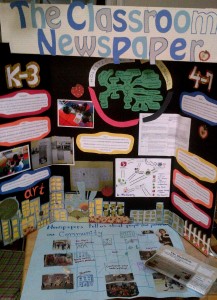I did it. Here is my posterboard for my kiosk on Friday. I will be introducing my integrated unit for Language Arts and Social Studies.
Here is a short reflection on how Aboriginal ways of knowing have influence my approach to this enactivist project.

Holistically Informed (Aboriginal influences)
Specific to this project:
The Aboriginal approach to teaching is very holistic and natural, valuing students to teach them about the interdependency and interrelationships between humans, nature, communities, and ecosystems. My plan to support my students in the publication of a classroom newspaper is informed by the holistic integration of all subjects. My vision for the classroom newspaper is that it will involve every student’s writing, reading, and presenting skills valuable in language arts education. It is also my intention to guide students in “big ideas” thinking, or to understand by design that both the creation or and content within newspapers is a reflection of community.
Students will learn to listen to stories and interviews from different people in our community, such as other teachers, older students, younger students, and their peers. In creating and reading their own newspapers, students may also become more aware of their school community and share what they are learning by oral tradition, to their families and friends. Students might demonstrate their willingness to participate in a variety of sharing activities that include the use of pictures, charts, storytelling, songs, lists, menus, and story books as part of the process of the newspaper production.
Additional learning:
The common thread between the stories by our Aboriginal speakers within this SSAEd course, as well as those that I’ve attended outside of the program, seem to be the place- based identity that weave their identity and ways of knowing together. It is one goal of many First Nations communities to re- integrate holistic understandings of space and time into a contemporary curriculum. I have learned to value all stories, and to appreciate the delicate threads that sometimes link a student’s connection to the lesson being taught. Sometimes that fragile connection bridges to a valuable teachable moment. Aboriginal culture teaches us to be respectful and patient with the patterns and circular nature of thinking. I particularly appreciate the layering effect, or scaffolding, of a student’s learning which is represented by the traditional valuing of seasonal knowledge.
There is room for further inquiry into how local Aboriginal history and culture can be incorporated into the classroom newspaper. It is possible to arrange a gallery walk of tools and objects valued by the local Aboriginal group. In this particular project plan, students will focus more on their school community in their writing and reporting. Regardless, the collection and compilation of stories, advice, personal opinion, and personal artwork will result in a holistic integration across many curricular subjects. Through the enactivism, students will use their mind, spirit, heart, and body to collaborate on this community project by generating understanding through connections with the world around us, then reflecting on feelings to engage in action and information sharing. This is a cyclical process that is in alignment with the Aboriginal medicine wheel representation of balance within self and society.
